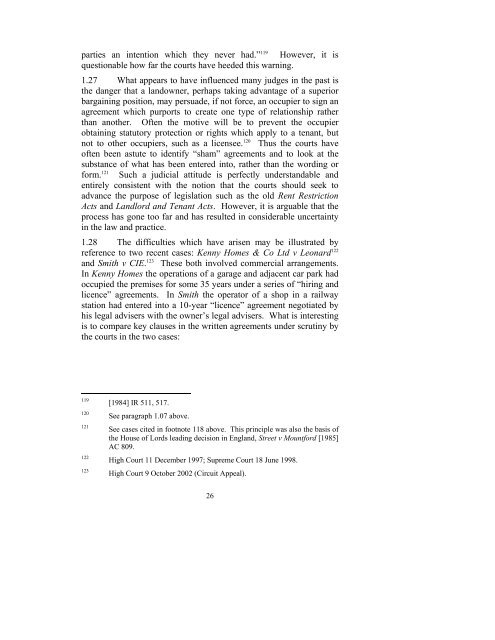Consultation Paper on the General Law of the Landlord and Tenant
Consultation Paper on the General Law of the Landlord and Tenant
Consultation Paper on the General Law of the Landlord and Tenant
You also want an ePaper? Increase the reach of your titles
YUMPU automatically turns print PDFs into web optimized ePapers that Google loves.
parties an intenti<strong>on</strong> which <strong>the</strong>y never had.” 119 However, it isquesti<strong>on</strong>able how far <strong>the</strong> courts have heeded this warning.1.27 What appears to have influenced many judges in <strong>the</strong> past is<strong>the</strong> danger that a l<strong>and</strong>owner, perhaps taking advantage <strong>of</strong> a superiorbargaining positi<strong>on</strong>, may persuade, if not force, an occupier to sign anagreement which purports to create <strong>on</strong>e type <strong>of</strong> relati<strong>on</strong>ship ra<strong>the</strong>rthan ano<strong>the</strong>r. Often <strong>the</strong> motive will be to prevent <strong>the</strong> occupierobtaining statutory protecti<strong>on</strong> or rights which apply to a tenant, butnot to o<strong>the</strong>r occupiers, such as a licensee. 120 Thus <strong>the</strong> courts have<strong>of</strong>ten been astute to identify “sham” agreements <strong>and</strong> to look at <strong>the</strong>substance <strong>of</strong> what has been entered into, ra<strong>the</strong>r than <strong>the</strong> wording orform. 121 Such a judicial attitude is perfectly underst<strong>and</strong>able <strong>and</strong>entirely c<strong>on</strong>sistent with <strong>the</strong> noti<strong>on</strong> that <strong>the</strong> courts should seek toadvance <strong>the</strong> purpose <strong>of</strong> legislati<strong>on</strong> such as <strong>the</strong> old Rent Restricti<strong>on</strong>Acts <strong>and</strong> <strong>L<strong>and</strong>lord</strong> <strong>and</strong> <strong>Tenant</strong> Acts. However, it is arguable that <strong>the</strong>process has g<strong>on</strong>e too far <strong>and</strong> has resulted in c<strong>on</strong>siderable uncertaintyin <strong>the</strong> law <strong>and</strong> practice.1.28 The difficulties which have arisen may be illustrated byreference to two recent cases: Kenny Homes & Co Ltd v Le<strong>on</strong>ard 122<strong>and</strong> Smith v CIE. 123 These both involved commercial arrangements.In Kenny Homes <strong>the</strong> operati<strong>on</strong>s <strong>of</strong> a garage <strong>and</strong> adjacent car park hadoccupied <strong>the</strong> premises for some 35 years under a series <strong>of</strong> “hiring <strong>and</strong>licence” agreements. In Smith <strong>the</strong> operator <strong>of</strong> a shop in a railwaystati<strong>on</strong> had entered into a 10-year “licence” agreement negotiated byhis legal advisers with <strong>the</strong> owner’s legal advisers. What is interestingis to compare key clauses in <strong>the</strong> written agreements under scrutiny by<strong>the</strong> courts in <strong>the</strong> two cases:119120121122123[1984] IR 511, 517.See paragraph 1.07 above.See cases cited in footnote 118 above. This principle was also <strong>the</strong> basis <strong>of</strong><strong>the</strong> House <strong>of</strong> Lords leading decisi<strong>on</strong> in Engl<strong>and</strong>, Street v Mountford [1985]AC 809.High Court 11 December 1997; Supreme Court 18 June 1998.High Court 9 October 2002 (Circuit Appeal).26
















